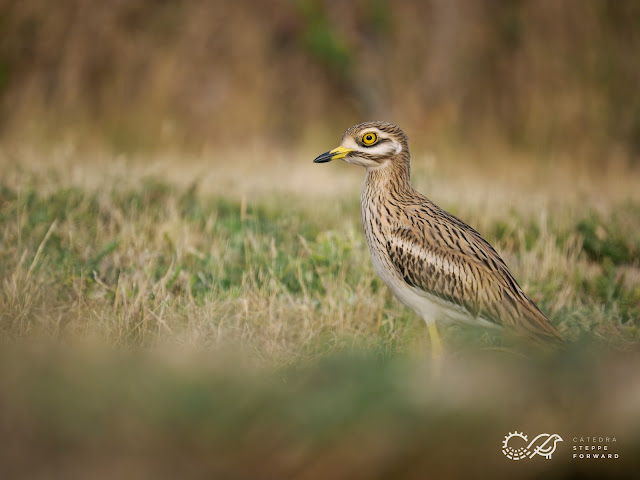Hábitat del alcaraván común
El alcaraván común es un ave de tamaño medio, asociada a medios abiertos y desarbolados como prados, pastos áridos y estepas naturales o seminaturales. En España, muestra preferencia por eriales y barbechos. Lamentablemente ha sufrido un declive poblacional significativo en Europa (20-50% en los últimos 20 años) y en España (>20% entre 1970 y 1990), lo que la ha llevado a ser catalogada como "vulnerable" en Europa y "casi amenazada" a nivel nacional.
 |
| Imagen: Cátedra Steppe Forward |
REFERENCIA:
The Eurasian Stone-Curlew (Burhinus oedicnemus) is a medium-sized bird typically found in open, treeless environments like meadows, arid pastures, and natural or semi-natural steppes. In Spain, it particularly favors fallow land and uncultivated fields. Unfortunately, it has experienced a significant population decline across Europe (20-50% in the last 20 years) and in Spain (>20% between 1970 and 1990). This has led to its classification as "Vulnerable" in Europe and "Near Threatened" at the national level.
A study conducted by Juan Traba and other researchers in two localities within the Community of Madrid—Valdetorres de Jarama and Campo Real—during the springs of 2005 and 2006, aimed to define the stone-curlew's habitat selection patterns at macro and microhabitat scales.
The study revealed that stone-curlews exhibited macrohabitat selection significantly different from what would be expected by chance. The main trends observed were:
- Positive selection for tilled fields, fallows, and uncultivated land. Fallow land and uncultivated fields were intensely used substrates in both years and areas.
- A tendency for positive selection of field margins (borders and paths). This, combined with the preference for fallows and uncultivated land, points to a predilection for heterogeneous agricultural landscapes, featuring a mosaic of variably used agricultural plots alongside abandoned ones.
- Systematic avoidance of cereal and legume crops, despite the large area cereals occupy in the study zone.
A closer look: Microhabitat selection
One of the study's most novel contributions is its detailed analysis of microhabitat selection, which demonstrated that the stone-curlew apparently selects a specific vegetation structure, rather than simply different types of broad substrates. This microhabitat selection pattern remained stable across localities, even with inter-annual variations or differences in substrate distribution.
The analysis identified two key ecological gradients influencing this selection:
- Vegetation Structural Complexity (Visibility-Cover): Stone-curlews showed a preference for locations with more bare ground and lower structural complexity of vegetation.
- Food Availability: Stone-curlews clearly selected spots with a higher presence of arable weeds and organic matter in the soil. These characteristics are associated with a greater presence of beetles (Coleoptera) and grasshoppers/crickets (Orthoptera), which form the basis of their diet.
This behavior suggests an evolutionary trade-off between easy access to food and an anti-predator strategy. More open sites not only offer greater visibility to detect predators but can also facilitate concealment thanks to their cryptic plumage and aid in foraging.
Conclusions and Conservation Recommendations
The extensive agroecosystems of the Iberian Peninsula are undergoing profound changes due to agricultural intensification, such as conversion to irrigation, reduction of fallow land, land consolidation, and herbicide use. These changes alter the availability of critical resources for birds, including food, nesting sites, and predator protection.
For birds like the stone-curlew, which show stable patterns of selecting specific vegetation structures, these changes have severe consequences for their conservation status, as they reduce their survival and reproductive success.
The main recommendation of this study is clear: habitat management must incorporate criteria related to maintaining a specific vegetation structure when designing management strategies. This means moving beyond the usual approach of maintaining certain percentages of surface area for generic agricultural uses, to focusing on the microhabitat characteristics that the species truly selects. Prioritizing the creation and maintenance of plots with bare ground, low-complexity vegetation, and the presence of arable weeds is fundamental to promoting the presence and reproductive success of the Eurasian Stone-Curlew in our agricultural landscapes.
Comentarios
Publicar un comentario